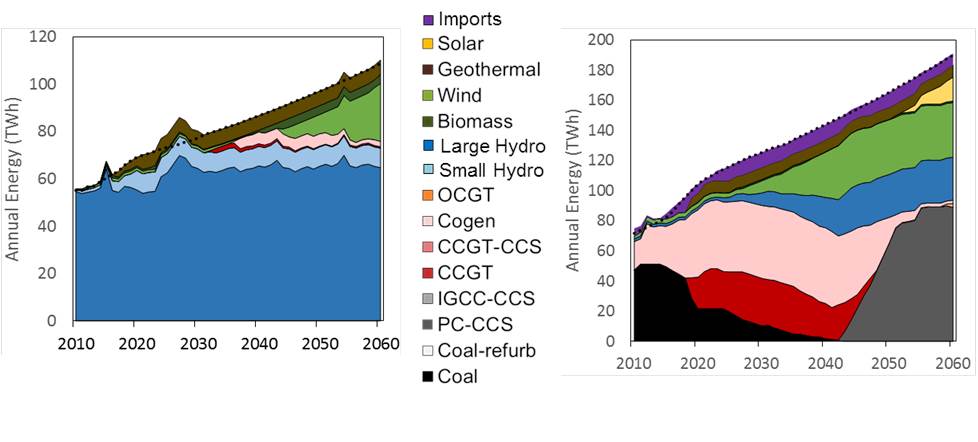Findings
CO2 and Increased Intertie Capacity between British Columbia and Alberta
The 2060 Project’s large scale regional perspective, based on resources and opportunism rather than political boundaries, allows 2060 researchers to determine the optimal system structure for the greater Canadian good. A techno-economic optimisation OSeMOSYS model was developed to determine the least cost electricity generation mix for the combined Alberta, a fossil fuel dominated jurisdiction, and British Columbia, a predominantly hydroelectric jurisdiction, region under differing carbon pricing and electrical intertie scenarios. Interestingly, study results indicate no benefit from increasing intertie capacity under current policies. Under more stringent carbon policies greater intertie transmission capacity lowers both overall costs and emissions. An 80% reduction in emissions from 2007 levels is achievable with a 10% increase in the net present cost of electricity generation. In all scenarios, natural gas generation replaces Alberta’s coal facilities – this gas-fired generation serves as a bridge between Alberta’s current coal-dominated generation mix and future low-carbon mixes. Effective carbon policy plays the dominant role in the reduction of carbon emission levels yet increased intertie transmission capacity provides additional value in total emission reductions.
Carbon Taxes and GHG Reductions in Alberta
As previously noted, Alberta currently relies primarily on coal for electricity generation. Retiring assets and long term demand growth in Alberta will require significant capacity additions, concurrent with pressure to reduce GHG emissions. A model of the Alberta power system was developed in OSeMOSYS to explore the impact of carbon taxes on GHG emissions and overall system costs. Findings indicate that carbon taxes speed up the decarbonisation process – although with decreasing effectiveness – and the system settles on similar carbon intensities by 2060, even in the absence of additional policy. Modest carbon taxes ($30/tCO2) accelerate the transition from coal to natural gas for baseload generation, providing cost-effective reductions. Natural gas-fired capacity provides valuable dispatchable generation, even if substantial build-out of wind and solar power occurs. Additional methane leakage from increased use of natural gas does not negate the GHG benefits of reduced coal combustion. Near-term carbon policy in Alberta and other coal-based power systems should focus on accelerating the retirement of coal plants.
Wave Energy Integration on Vancouver Island
Wave energy is the one of the most energy dense forms of renewable energy and is yet to be utilized due to concerns about reliability, costs and impact of grid systems. Utilizing the PLEXOS® Integrated Energy Model software, a detailed model was developed to quantify the opportunities for large-scale wave energy integration on Vancouver Island, with the implications of realistic transmission constraints. The study findings indicate that development of 500 MW of wave energy generation can decrease the energy dependency of Vancouver Island by 11% but the current grid infrastructure is not adequate to fully support 500 MW of wave power. Through the capacity expansion of four transmission lines, 500MW of wave energy is able to reduce annual energy demand by 15% and reduce peak power demand by up to 14%. Additionally, results illustrate that wave integration leads to periodic (and therefore predictable) reduction in the monthly energy consumed in the grid – a trend of particular importance when managing hydro-dominated grids.
Storage and Renewable Energy Resources
Frequently studies detailing the theoretical implementation of variable energy resources are published in popular media and scientific literature. However, assumptions regarding efficiency, time of generation and capability of storage systems result in significant uncertainty and provide misleading results on the true potential of renewables. In order to provide a scientifically reasoned response to these works, 2060 researchers assessed the impact of the storage efficiency and it’s impact on solar PV installations. Assuming a continuous load of 1GW, the OSeMOSYS model results indicate that ~5 GW of solar installed capacity and 1.1 TWh of 100% efficient storage is required. In more realistic terms, with a storage model based on the worlds’ largest pumped hydro facility (Bath County Facility – 30 GWh) running at 70% efficiency, requires 22.3 GW of installed solar capacity to meet a 1GW continuous demand. This represents 450% more installed solar capacity than previous published articles. This research indicates that studies focussing on shifting away from fossil fuels to renewable/variable energy resources, based on simply considering the capacity factor of the energy source, significantly underestimate the costs and infrastructure requirements.
